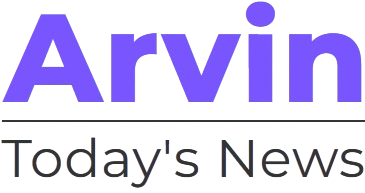Pixar has an uncanny ability to embed itself into the fabric of childhood, ultimately becoming one of the defining factors in a child’s early experiences with storytelling, imagination, and emotional learning. Moreover, who can forget its iconic lamp in the Pixar logo?
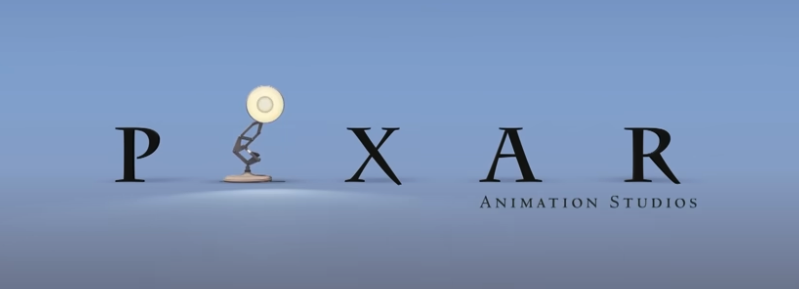
Great logos tell great stories. Pixar’s is a testament to how simple design can carry deep meaning. Arvin AI Logo Designer offers you the opportunity to craft a logo that’s uniquely yours, combining simplicity, creativity, and meaning into one unforgettable symbol.
Meet Pixar
Picture this: a wide-eyed child sitting in awe as Buzz Lightyear declares his quest for infinity and beyond in Toy Story, or as the vibrant characters of Inside Out gently explain the complexity of emotions through Joy, Sadness, and the rest of the crew.
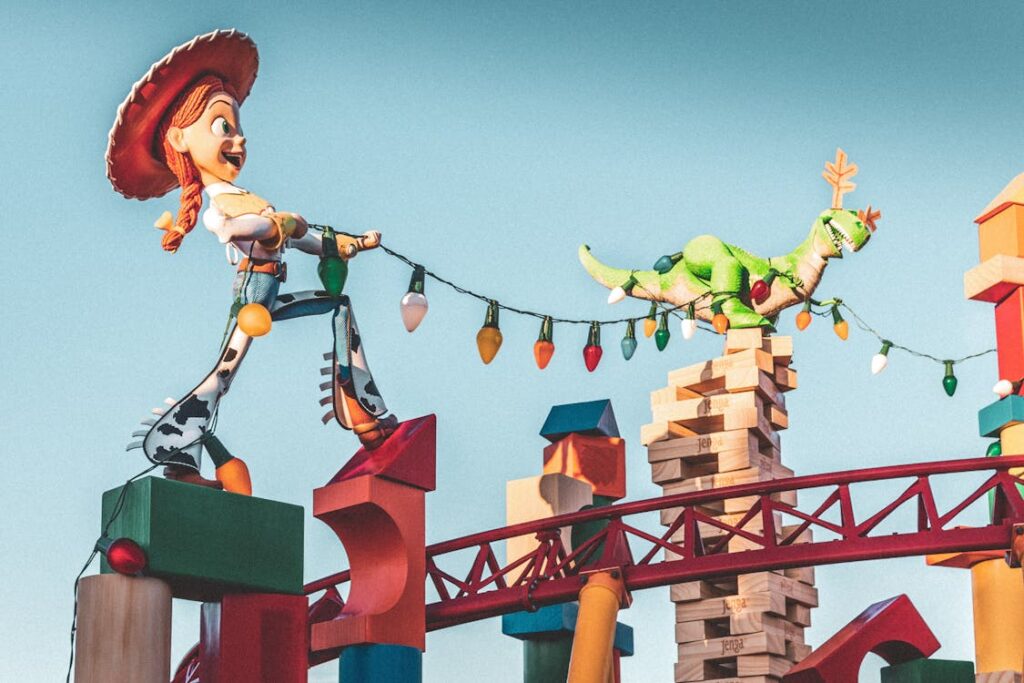
From their very first feature film, Pixar has mastered the art of blending stunning visuals with narratives that resonate universally. For example, in Finding Nemo, kids are enchanted not just for the colorful marine life but for its heartfelt tale of bravery, friendship, and a father’s love. Meanwhile, the high-speed escapades of Cars teach young viewers about humility and teamwork, as Lightning McQueen learns that winning isn’t everything.

But beyond the spectacle, Pixar films introduce profound values. The Incredibles showcases the strength of family bonds and the importance of embracing one’s unique abilities, while Coco celebrates cultural heritage and the enduring power of memory. And who can forget the poignant message of Up, where a child learns that adventure isn’t just about flying to distant lands but cherishing the everyday moments with loved ones?
About Pixar
Steve Jobs
Pixar’s journey began as a small yet ambitious part of Lucasfilm’s computer division in 1979, originally known as the Graphics Group. At first, it was a hub for pioneering computer animation techniques, yet its potential was undeniable. Then, by 1986, a pivotal moment occurred when Steve Jobs, fresh off his departure from Apple, saw promise in the fledgling company. Consequently, he purchased it for $10 million, investing not just his money but his unwavering belief in its vision. Ultimately, this marked the official birth of Pixar as an independent entity.
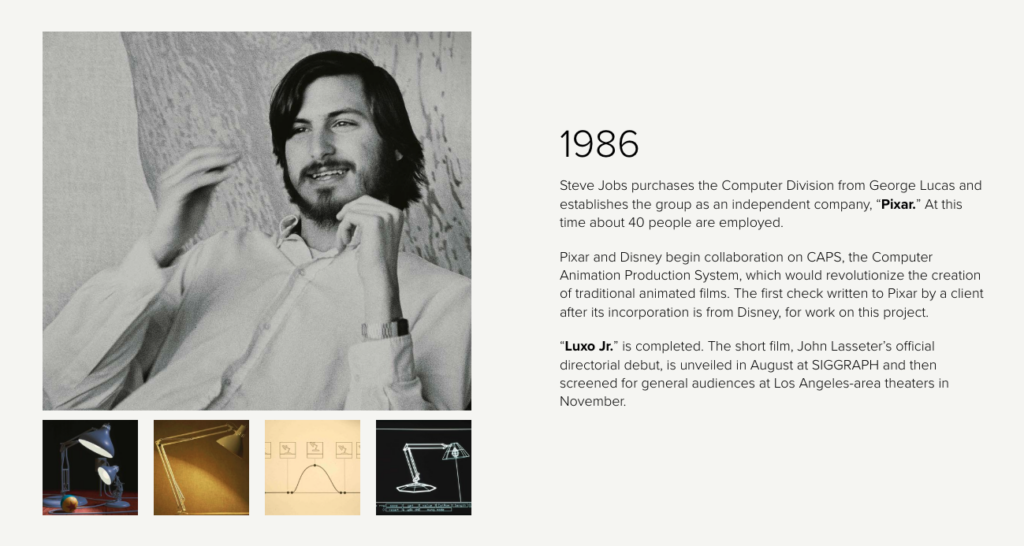
Jobs was instrumental in shaping Pixar’s trajectory, combining his knack for innovation with a keen eye for storytelling. Under his leadership, Pixar released its first short film, Luxo Jr., which not only introduced the world to the iconic desk lamp mascot but also earned an Academy Award nomination.
Jobs once remarked,
“Pixar is seen by a lot of folks as an overnight success, but if you really look closely, most overnight successes took a long time.”
Walt Disney
In 1991, Pixar forged a game-changing partnership with Walt Disney Studios, which led to an agreement to co-produce animated feature films. As a result, this collaboration brought forth the groundbreaking Toy Story (1995), the first-ever fully computer-animated feature film. Subsequently, the movie’s success skyrocketed Pixar to fame, demonstrating that technology and storytelling could coexist seamlessly.

When Disney acquired Pixar in 2006 for $7.4 billion, it marked a pivotal moment that solidified their creative alliance. More than just a business move, this merger served as a testament to Pixar’s exceptional ability to elevate Disney’s animation legacy.
Bob Iger, Disney’s CEO at the time, said,
“What I saw was that the creative engine of Disney animation was being fueled by Pixar.”
Steve Jobs believed in building something extraordinary—why not do the same with your brand? Use Arvin AI Logo Designer to craft a logo that stands out.
Evolution of Pixar
1979–1986: The Lucasfilm Years
Pixar’s story began in 1979 as the Graphics Group, a subdivision of Lucasfilm’s Computer Division. Guided by the leadership of Ed Catmull and Alvy Ray Smith, the group quickly became known for pioneering advancements in computer graphics. Notably, they developed the Alpha Channel, which revolutionized visual effects by enabling seamless compositing of image layers.

They also developed REYES (Render Everything You Ever Saw), a precursor to the industry-standard RenderMan. Early CGI experiments included the groundbreaking Genesis Effect in Star Trek II: The Wrath of Khan and the Stained Glass Knight in Young Sherlock Holmes. These innovations established the foundation for Pixar’s future.
However, Lucasfilm’s financial pressures, driven in part by George Lucas’ divorce, nearly brought this venture to an end. In response, the Graphics Group sought a lifeline, and their shared vision eventually converged with a new investor: Steve Jobs. At the same time, the team’s technical brilliance faced obstacles in the form of social challenges, such as skepticism about the viability of computer-generated imagery.
1986–1990: Steve Jobs Steps In
In 1986, Steve Jobs acquired the Graphics Group for $5 million, rebranding it as Pixar and infusing another $5 million as working capital. Initially, Pixar focused on selling the Pixar Image Computer, targeting industries like medicine and science. However, commercial success eluded them.

Pixar’s breakthrough came with the 1986 short film Luxo Jr., which not only introduced the studio’s mascot—a bouncy desk lamp—but also demonstrated the storytelling potential of CGI. The short earned critical acclaim and an Academy Award nomination, showcasing Pixar’s ability to infuse emotion into technology. While this period saw financial struggles, Jobs’ unwavering support and creative ambition kept the company afloat, laying the groundwork for its transformation into a storytelling powerhouse.
As Steve Jobs famously said,
“Pixar is about making something that changes people’s perceptions, not just creating a product.”
1991–2008: Disney Partnership and Breakthroughs
In 1991, Pixar signed a historic $26 million deal with Disney to produce three computer-animated feature films. As a result of this collaboration, Toy Story (1995) was created—the first fully computer-animated feature film, which grossed $373 million worldwide. Building on this success, Pixar went public in 1995, with its IPO becoming the year’s most lucrative.
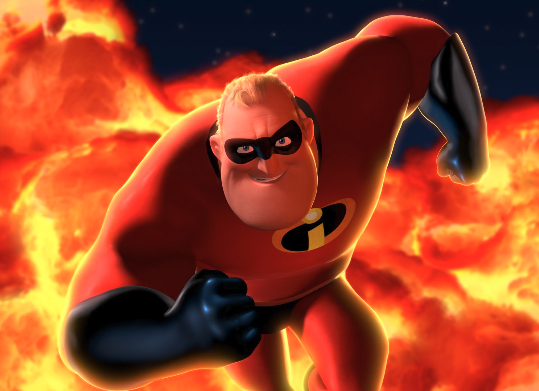
Pixar’s technological achievements during this era were unparalleled. RenderMan, the studio’s proprietary rendering software, became an industry standard, used in films across Hollywood. The studio also developed a sophisticated animation pipeline, enabling groundbreaking visual storytelling in films like Finding Nemo (2003) and The Incredibles (2004).
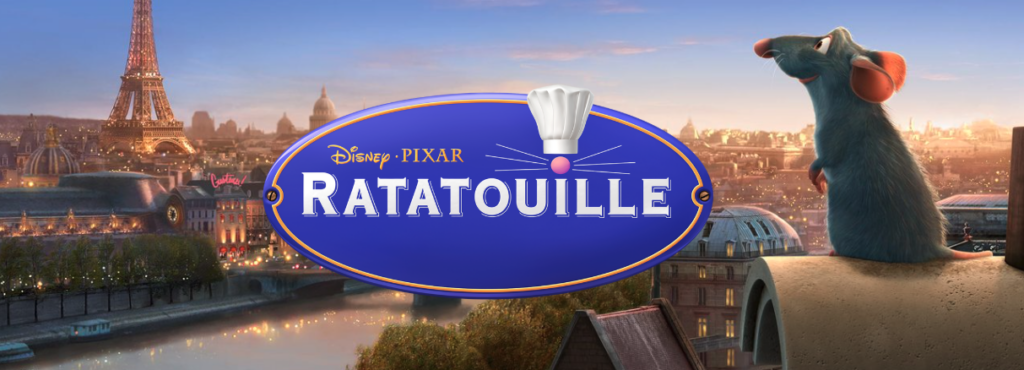
Socially, Pixar became known for crafting stories that explored universal themes of family, individuality, and resilience. For example, films like Monsters, Inc. (2001) and Ratatouille (2007) resonated deeply with audiences worldwide. Then, in a pivotal moment in 2006, Disney acquired Pixar for $7.4 billion, with Steve Jobs becoming Disney’s largest individual shareholder. This acquisition not only secured Pixar’s continued growth but also allowed the studio to maintain its creative independence under the leadership of Ed Catmull and John Lasseter.
2009–Today: Growth and Innovation

Pixar’s growth continued with films like Up (2009), which became the first animated film to open the Cannes Film Festival. Building on this success, the studio expanded its storytelling techniques, incorporating hybrid formats with live-action and 2D animation, as demonstrated in Soul (2020). At the same time, Pixar pushed boundaries technologically, achieving remarkable advancements in rendering, lighting, and character animation. These innovations further solidified Pixar’s reputation as a leader in both creative storytelling and cutting-edge technology.
The rise of streaming platforms presented new challenges and opportunities. In response to these shifting dynamics, Pixar adapted during the COVID-19 pandemic by releasing films like Turning Red (2022) directly on Disney+, bypassing traditional theatrical releases. Although this strategy ensured broader audience reach, it also raised concerns among employees about the potential loss of the cherished cinematic experience. Nevertheless, this shift highlighted Pixar’s ability to remain flexible while navigating an evolving entertainment landscape.
Despite setbacks like Lightyear (2022), which underperformed financially, Pixar demonstrated remarkable resilience with Elemental (2023). Although the film faced a slow start at the box office, it eventually turned profitable, proving Pixar’s enduring ability to connect with audiences.
Pixar evolves with the times, and so can your branding. Let Arvin AI Logo Designer help you craft a logo that adapts with your vision.
Pixar’s Competitors
| Competitor | Founded | Notable Films | Strengths | Innovations | Market Strategies |
| Walt Disney Animation Studios | 1923 | The Lion King, Frozen, Encanto | Legacy in hand-drawn and CGI blending, strong musical storytelling, global recognition | Blended CGI and hand-drawn techniques | Strong presence on Disney+ and extensive merchandising |
| DreamWorks Animation | 1994 | Shrek, How to Train Your Dragon, Kung Fu Panda | Humor-driven narratives, diverse storytelling styles | MoonRay rendering engine | Appeals to family audiences with a balance of humor for kids and adults |
| Illumination Entertainment | 2007 | Despicable Me, Sing, The Super Mario Bros. Movie | Cost-efficient production, broad commercial appeal, strong brand recognition | Lean production techniques | Extensive merchandising (Minions as a global brand) |
| Sony Pictures Animation | 2002 | Spider-Man: Into the Spider-Verse, The Mitchells vs. the Machines | Innovative visual styles, bold storytelling | Arnold rendering engine | Utilizes streaming platforms and experimental aesthetics |
| Laika | 2005 | Coraline, Kubo and the Two Strings, Missing Link | Unique stop-motion animation, mature and darker themes | Proprietary stop-motion technologies | Appeals to niche audiences, focusing on artistic craftmanship |
Pixar Logo Meaning
The Pixar logo embodies the studio’s core principles of innovation, simplicity, and storytelling. Its sleek and minimalist design, featuring the word “PIXAR” in an elegant font, highlights the company’s commitment to clarity and creativity.
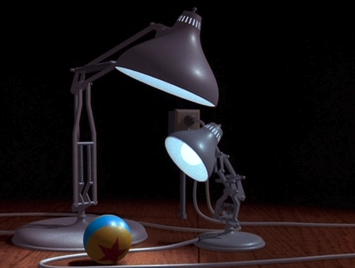
The inclusion of Luxo Jr., the animated desk lamp that replaces the letter “I,” symbolizes Pixar’s pioneering role in computer animation and its ability to infuse life and personality into inanimate objects.
Ed Catmull, Pixar’s co-founder, has often emphasized the studio’s dedication to innovation. He once noted:
“We start from the presumption that our goal is to make something that has never been seen before.”
This ethos is perfectly reflected in the logo’s design, which merges technical precision with an element of playfulness—qualities that are at the heart of Pixar’s filmmaking approach.
Pixar Logo Design

Color Palette
The black-and-white color scheme and the absence of gradients or complex colors simplify printing and digital reproduction, ensuring fidelity across different resolutions and materials.
Black provides a strong contrast against lighter backgrounds, emphasizing the wordmark without the distraction of additional visual elements.
Pixar Logo Lamp

Luxo Jr., the desk lamp introduced in Pixar’s first animated short, is a key component of the logo’s animated form. The lamp replaces the “I” in Pixar and becomes a dynamic character in itself during the iconic film intros.
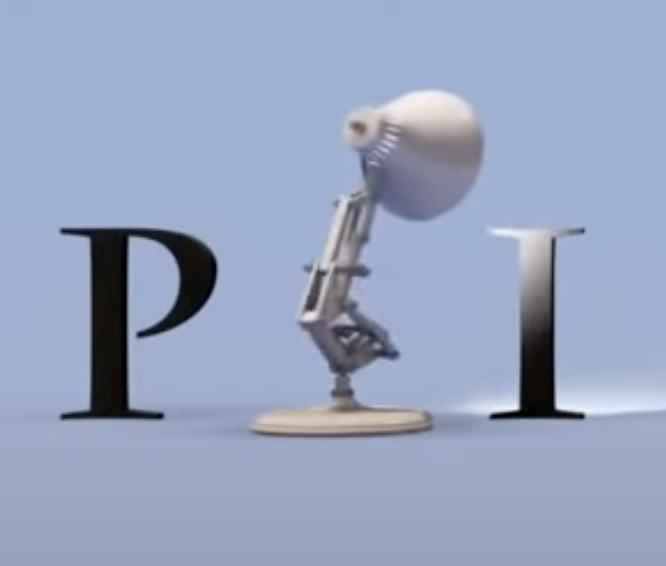
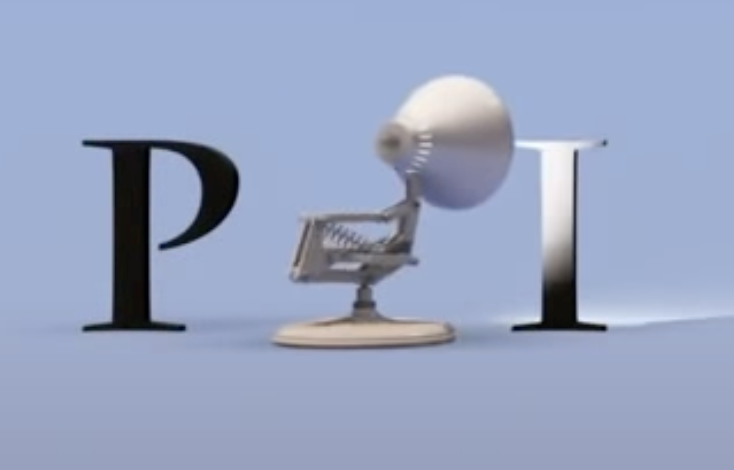
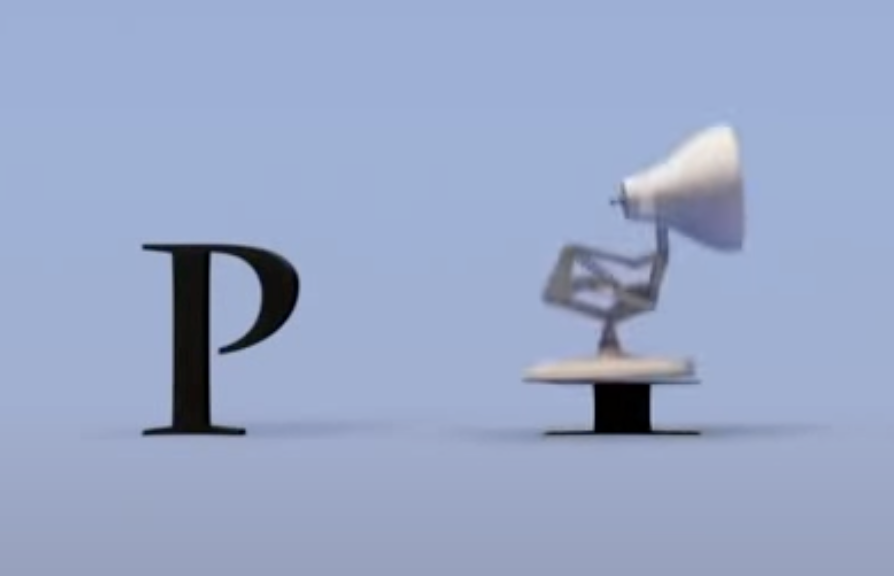
Luxo Jr.’s movements in the animated logo showcase advanced principles of animation, such as squash and stretch, anticipation, and secondary action. These techniques make the lamp appear lifelike and imbued with personality.
- Physics Simulation: Elements like the lamp’s bounce or interactions with the environment are governed by physical accuracy, enhancing believability.
- Ray Tracing: The realistic rendering of shadows and light in the animation showcases RenderMan’s capabilities, a software developed and used by Pixar for its films.
- Rigging: The lamp’s movements rely on a carefully crafted skeleton structure, allowing fluid and realistic motion.
The lamp embodies Pixar’s innovation in character-driven storytelling and its pioneering role in computer-generated animation.
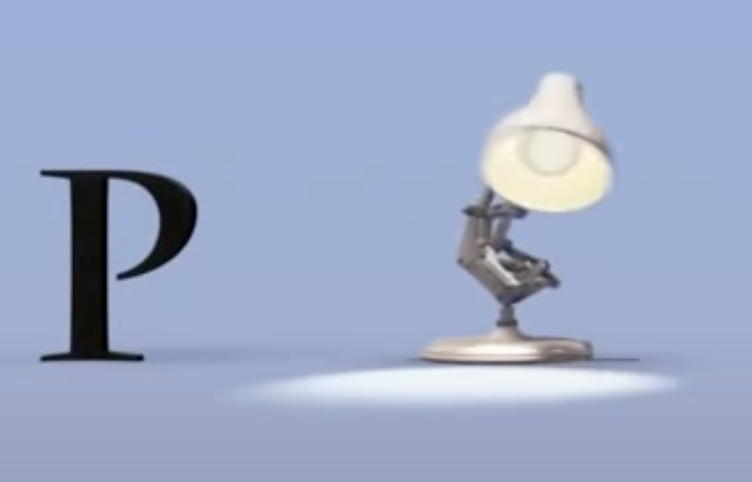
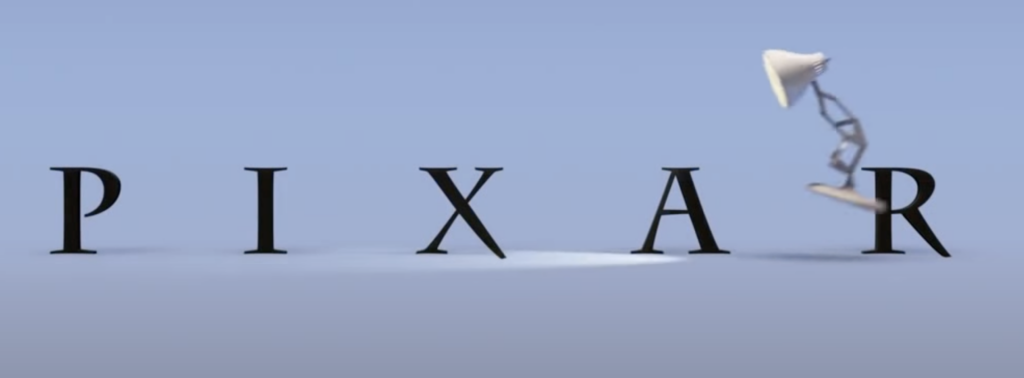
The animation features realistic lighting and shadow effects, achieved using Pixar’s proprietary RenderMan software. Luxo Jr.’s interactions with the environment, such as casting shadows and reflecting light, are demonstrations of technical prowess.
The animated Pixar logo is a masterclass in computer graphics and animation. Luxo Jr.’s presence demonstrates Pixar’s advancements in multiple areas of animation technology:
1979-1986

This period saw the rise of digital technologies in filmmaking, and The Graphics Group played a pivotal role in introducing computer-generated imagery (CGI)
The logo features a red and black circular symbol split into two halves, with the letters “G” and “P” (standing for Graphics Group) interconnected. This conveys symmetry and integration, which aligns with their work in blending technology and creativity.
The text uses a clean sans-serif font, combining red and black to emphasize “ART” in “The Art of Visual Communication,” symbolizing their focus on both technical precision and artistic innovation.
1986 – 1994

This was Pixar’s branding from 1986 to 1994, during its early independent years after being spun off from Lucasfilm. This period marked Pixar’s transition from a hardware company into a leader in animation technology.
Pixar’s logo from 1986 to 1994 subtly reflects design philosophy associated with Apple, a company closely tied to Pixar through Steve Jobs. Jobs, acquired Pixar in 1986 and invested heavily in its future. He brought with him a minimalist, design-forward ethos that was already a hallmark of Apple’s branding and product development. While the logo doesn’t directly borrow elements from Apple’s iconic branding, they shared an emphasis on minimalism and innovation. This likely reflects Steve Jobs’ influence on both companies during this formative period.
The clean, geometric design of Pixar’s logo, with its emphasis on precision and depth, aligns with the simplicity and clarity Apple championed in its early product designs and marketing. Jobs’ vision for Pixar as more than a tech company. It was an organization capable of blending artistry and technology, akin to how he viewed Apple as a transformative force in the tech world.
Steve Jobs’ Effect
The design featured a three-dimensional square with a circular cutout at its center. The shading within the circle and the cube added depth, pushing the boundaries of light and shadow. This is an essential element in computer-generated imagery. Below the graphic, the company name “P I X A R” appeared with dots separating each letter, lending the logo a clean, modern aesthetic. This parallels to the technical and academic audiences Pixar catered to during its hardware-focused years.
This minimalist yet sophisticated design served as a visual nod to Pixar’s core mission: blending technology with creativity. The geometric elements of the logo symbolized a “window into the digital world,” representing the company’s groundbreaking work in computer graphics.
During this time, Pixar primarily marketed its Pixar Image Computer to industries such as science and government, while quietly building its animation credentials through projects like Luxo Jr. (1986).
1994 – Today

“The best scientists and engineers are just as creative as the best storytellers.”
– Ed Catmull
| Rank | Title | Release Year | Worldwide Gross |
| 1 | Inside Out 2 | 2024 | $1,698,641,117 |
| 2 | Incredibles 2 | 2018 | $1,242,805,359 |
| 3 | Toy Story 4 | 2019 | $1,073,394,593 |
| 4 | Toy Story 3 | 2010 | $1,066,969,703 |
| 5 | Finding Dory | 2016 | $1,028,570,889 |
Pixar Logo with Characters
Duke Caboom and Combat Carl Soldier Variant
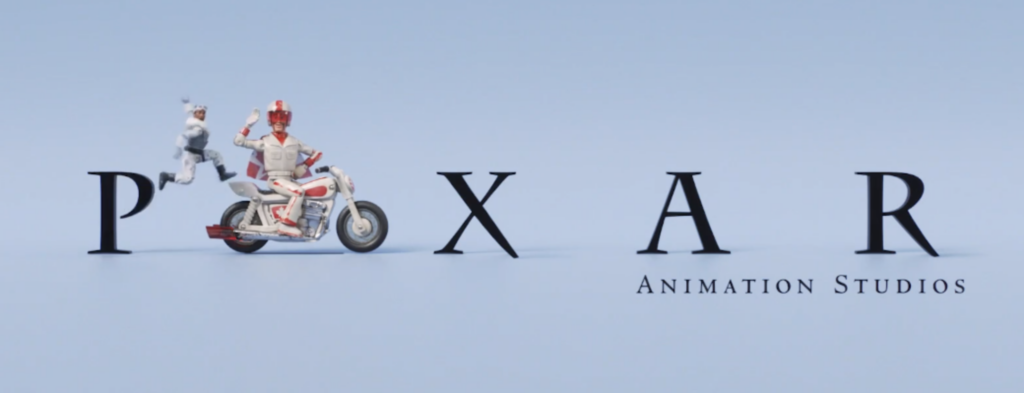
As John Lasseter once said:
“Every single frame of a Pixar film has the potential to tell a story.”
This Pixar logo variation, inspired by Toy Story 4, showcases Pixar’s signature blend of creativity and humor. Instead of the iconic Luxo Jr. lamp hopping into its spot to replace the “I” in “PIXAR,” this sequence introduces Duke Caboom, the charismatic daredevil voiced by Keanu Reeves. Riding his motorcycle into the frame, Duke dramatically bounces the “I” down as part of his stunt, injecting a thrilling and playful energy.
Adding a humorous and heartwarming touch, a Combat Carl Soldier—referencing the running gag in Toy Story 4 where the character misses out on high-fives—finally gets his long-awaited high-five from Duke. This small yet meaningful detail not only adds levity but also showcases Pixar’s knack for storytelling, even in its branding moments.
The sequence uses a simplified 2D version of the Pixar logo with added depth, seamlessly fitting into both 2D and 3D formats.
Ratatouille Variant
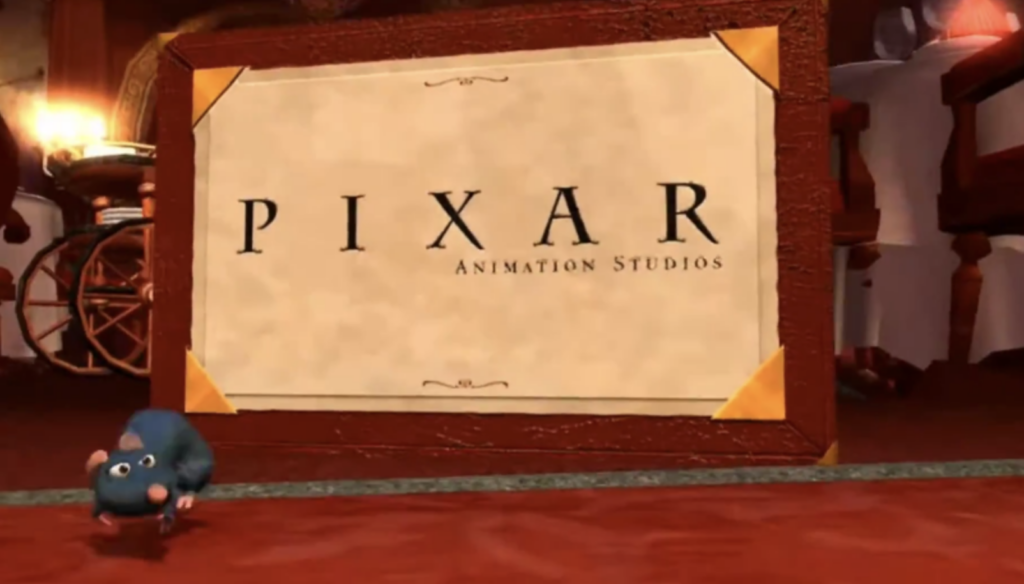
As Brad Bird, the director of Ratatouille, once remarked;
“Pixar’s secret sauce is its commitment to the story first, no matter what.”
Instead of the typical clean and minimalist Pixar logo, this version is presented on what resembles an aged parchment, framed with ornate corners, evoking the warmth and elegance of a fine dining restaurant menu. The backdrop is rich and textured, immersing the viewer in the refined, French-inspired atmosphere central to the movie.
In the foreground, Remy, the film’s protagonist, a lovable rat with extraordinary culinary talent, makes a playful entrance, adding personality and context to the logo. His appearance ties directly to the movie’s themes of ambition, creativity, and embracing one’s unique talents.
WALL-E Variant
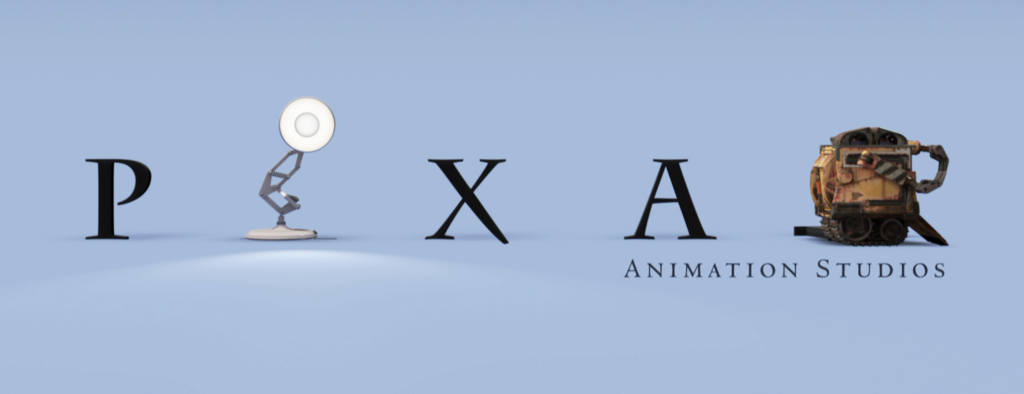
In the first image, the iconic Pixar lamp, Luxo Jr., is accompanied by WALL-E, the lovable protagonist from Pixar’s WALL-E. While Luxo Jr. performs its classic hop and replaces the “I,” WALL-E adds a mechanical touch, integrating his personality into the animation.
Incredibles Variant
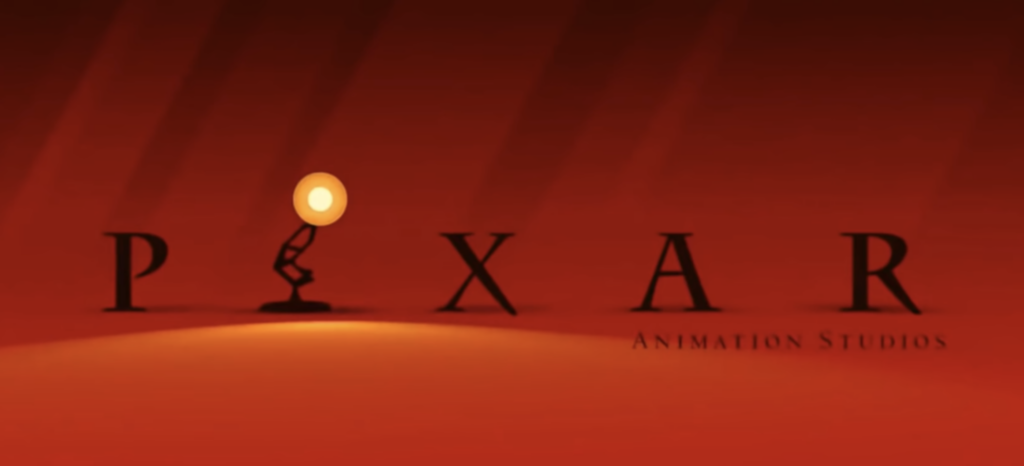
For Incredibles 2, Pixar embraced the superhero aesthetic by swapping the traditional blue backdrop for a bold red, symbolizing power, energy, and the larger-than-life themes of the movie. As Brad Bird, director of The Incredibles, once explained, “Pixar’s strength lies in creating characters and worlds that are not just entertaining but deeply human.”
Luxo Jr. appears in sleek black with a glowing yellow light, embodying the heroic colors associated with the Incredibles family.
Pixar Popcorn Variant
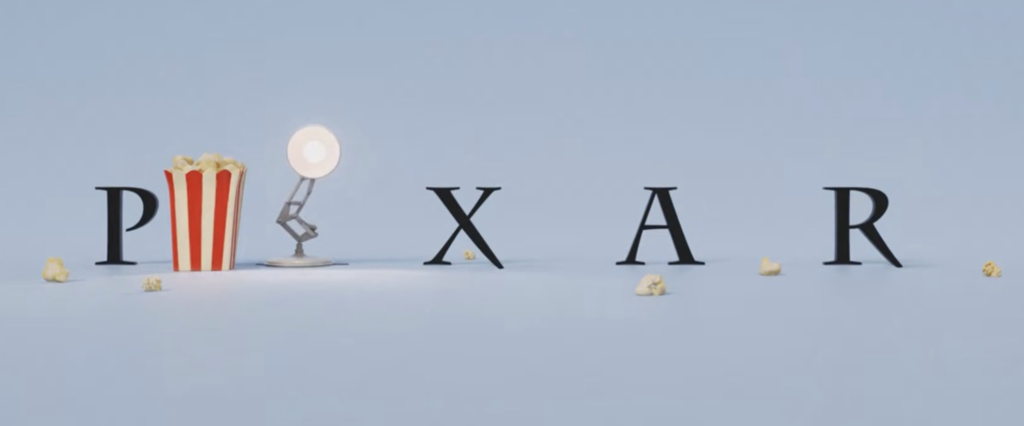
Pixar Logo Font
Wordmark Typography
The Pixar wordmark employs a serif typeface inspired by Charlemagne Standard-Bold, which balances classical aesthetics with a modern twist. The font features elongated serifs and unique stylizations, particularly in the “X” and “R,” creating a visually distinctive yet understated identity.
Kerning and Alignment: The consistent spacing between letters ensures readability at any size, from film credits to promotional materials. This technical refinement makes the wordmark adaptable across various media platforms.
Font Structure: Serif fonts are often used to convey authority and tradition, while the customized letters reflect Pixar’s innovative and creative approach. The sharp angles of the “X” and the curvature of the “R” suggest a marriage of precision and imagination.
Pixar Today
Pixar today remains a powerhouse in the animation industry, seamlessly blending cutting-edge technology with deeply emotional storytelling that continues to captivate audiences across generations. As a subsidiary of Walt Disney Studios, Pixar has carved a unique identity as a pioneer in computer-generated animation, consistently redefining the limits of visual storytelling.

However, the rise of streaming services has significantly changed how the world consumes media. A generation of children is growing up with little to no exposure to the tradition of catching new releases in theaters—a shift that has prompted Pixar to adapt its strategies. Recognizing this evolving landscape, Pixar is branching into television, marking an exciting new chapter for the studio. The highly anticipated Win or Lose, set to debut in February 2025 on Disney+, exemplifies this expansion. This original animated series showcases Pixar’s renowned storytelling in a fresh episodic format, exploring themes of perspective and teamwork.

Moreover, spin-offs and short films from established franchises, such as Toy Story of Terror! and Monsters at Work, allow Pixar to dive deeper into the worlds of its beloved characters while catering to audiences who crave shorter, more accessible content.
In recent years, Pixar has embraced advanced tools like machine learning and AI, revolutionizing its animation workflows. These technologies enable the studio to create even more lifelike characters and environments, enriching the visual and emotional depth of its stories. By staying at the forefront of innovation, Pixar ensures its legacy as a creative and technological trailblazer while remaining deeply connected to the hearts of its audience.
Much like Pixar’s lamp, a logo can light the way to success. Arvin AI Logo Designer is your key to designing something extraordinary.
Final Words
The Pixar logo, much like its films, reminds us that the smallest details can carry the deepest meaning. Whether it’s bringing life to a bouncing desk lamp or crafting unforgettable tales of courage, family, and adventure, Pixar continues to lead the way in animation and creativity, proving that imagination truly has no limits.
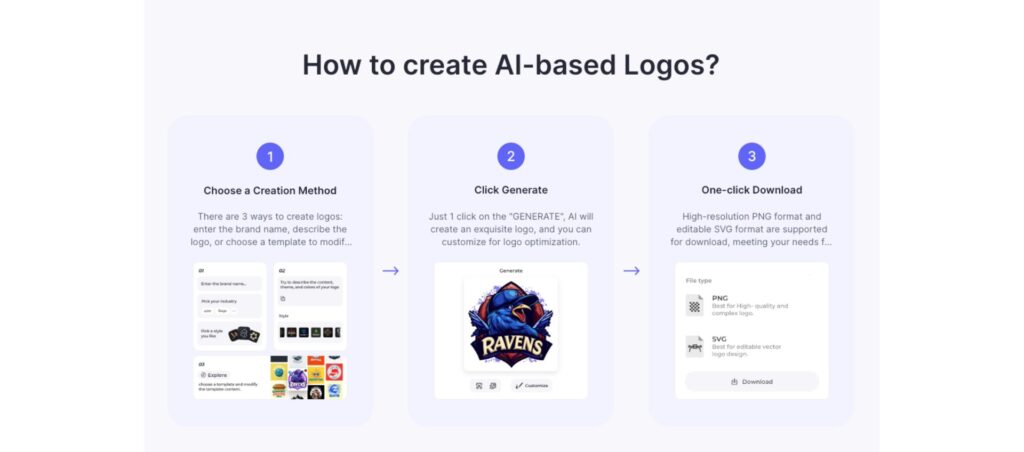
Ready to bring your own story to life? Arvin AI Logo Designer makes it simple to craft a logo that speaks volumes about your brand. Whether you’re building a business or creating something personal, Arvin AI helps you design with style, precision, and a spark of creativity.
Take the next step and let Arvin AI help your ideas shine—because every great story deserves a great logo!
FAQ
The symbol of Pixar is the Luxo Jr. lamp, which became iconic after its debut in the short film Luxo Jr. (1986). The lamp is featured in Pixar’s logo animation, playfully hopping in to replace the “I” in the word Pixar.
The Pixar logo symbolizes creativity, innovation, and storytelling. The inclusion of Luxo Jr., a desk lamp, reflects Pixar’s history and commitment to character-driven narratives. The logo serves as a reminder of the studio’s humble beginnings and its focus on making everyday objects come to life with emotion and personality.
The lamp represents Luxo Jr., the main character in Pixar’s first-ever animated short film. This short was pivotal in showcasing Pixar’s ability to create lifelike animation and tell emotionally engaging stories. The lamp is a tribute to Pixar’s origins and technological breakthroughs in animation.
No, Pixar is not owned by Apple. Although Steve Jobs, Apple’s co-founder, purchased Pixar in 1986 and served as its CEO, Pixar was acquired by The Walt Disney Company in 2006 for $7.4 billion. Since then, Pixar has operated as a subsidiary of Walt Disney Studios. Steve Jobs became Disney’s largest individual shareholder following the acquisition.
